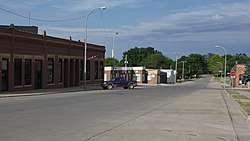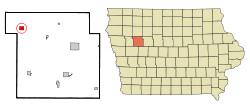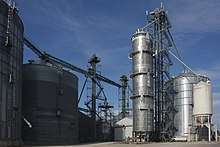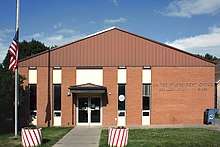Schaller, Iowa
Schaller is a city in Sac County, Iowa, United States. The population was 772 at the 2010 census.
Schaller, Iowa | |
|---|---|
 Eastward view along 2nd St. | |
 Location of Schaller, Iowa | |
| Coordinates: 42°29′50″N 95°17′39″W | |
| Country | |
| State | |
| County | Sac |
| Area | |
| • Total | 1.26 sq mi (3.26 km2) |
| • Land | 1.26 sq mi (3.26 km2) |
| • Water | 0.00 sq mi (0.00 km2) |
| Elevation | 1,411 ft (430 m) |
| Population | |
| • Total | 772 |
| • Estimate (2019)[3] | 723 |
| • Density | 574.27/sq mi (221.75/km2) |
| Time zone | UTC-6 (Central (CST)) |
| • Summer (DST) | UTC-5 (CDT) |
| ZIP code | 51053 |
| Area code(s) | 712 |
| FIPS code | 19-71085 |
| GNIS feature ID | 0465956 |
History

The city of Schaller, named after Phillip Schaller,[4] was incorporated in 1882. The city had been founded in August 1879 as a station for the railroad under construction. The economy, then as now, was based on commercial support for surrounding farms. Settlers came mostly from Germany, England, Canada, New York, and eastern Iowa. Throughout the middle part of the twentieth century a major industry consisted of the packers of Bango and Jolly Time popcorn. The presence and size of these two companies helped Schaller become "The Popcorn Capital of the world." Popcorn is still a major area industry, but the companies moved on to other locations in the 1980s. The railroad ceased operations and pulled up tracks in the 1970s. Transportation connections are by U.S. Route 20 and Iowa Highway 110. Corn (seed and feed), soybeans, and feeder cattle are the major products of the area.
Geography
Schaller is located at 42°29′50″N 95°17′39″W (42.497325, -95.294219).[5]
According to the United States Census Bureau, the city has a total area of 1.26 square miles (3.26 km2), all land.[6]
Demographics
| Year | Pop. | ±% |
|---|---|---|
| 1890 | 333 | — |
| 1900 | 661 | +98.5% |
| 1910 | 646 | −2.3% |
| 1920 | 731 | +13.2% |
| 1930 | 724 | −1.0% |
| 1940 | 758 | +4.7% |
| 1950 | 841 | +10.9% |
| 1960 | 896 | +6.5% |
| 1970 | 835 | −6.8% |
| 1980 | 832 | −0.4% |
| 1990 | 768 | −7.7% |
| 2000 | 779 | +1.4% |
| 2010 | 772 | −0.9% |
| 2019 | 723 | −6.3% |
| Source:"U.S. Census website". United States Census Bureau. Retrieved 2020-03-28. and Iowa Data Center Source: | ||
2010 census
As of the census[2] of 2010, there were 772 people, 318 households, and 208 families living in the city. The population density was 612.7 inhabitants per square mile (236.6/km2). There were 341 housing units at an average density of 270.6 per square mile (104.5/km2). The racial makeup of the city was 93.5% White, 0.1% African American, 0.1% Native American, 0.3% Asian, 0.1% Pacific Islander, 3.0% from other races, and 2.8% from two or more races. Hispanic or Latino of any race were 9.6% of the population.
There were 318 households of which 31.4% had children under the age of 18 living with them, 51.3% were married couples living together, 9.1% had a female householder with no husband present, 5.0% had a male householder with no wife present, and 34.6% were non-families. 29.6% of all households were made up of individuals and 12% had someone living alone who was 65 years of age or older. The average household size was 2.43 and the average family size was 3.04.
The median age in the city was 38.8 years. 27.2% of residents were under the age of 18; 7.1% were between the ages of 18 and 24; 24% were from 25 to 44; 24.8% were from 45 to 64; and 16.8% were 65 years of age or older. The gender makeup of the city was 49.2% male and 50.8% female.
2000 census

As of the census[8] of 2000, there were 779 people, 321 households, and 216 families living in the city. The population density was 619.4 people per square mile (238.7/km2). There were 347 housing units at an average density of 275.9 per square mile (106.3/km2). The racial makeup of the city was 97.82% White, 0.13% African American, 0.26% Native American, 0.26% Asian, 0.13% Pacific Islander, 0.64% from other races, and 0.77% from two or more races. Hispanic or Latino of any race were 3.08% of the population.
There were 321 households out of which 30.2% had children under the age of 18 living with them, 54.8% were married couples living together, 9.3% had a female householder with no husband present, and 32.4% were non-families. 28.7% of all households were made up of individuals and 14.0% had someone living alone who was 65 years of age or older. The average household size was 2.43 and the average family size was 2.97.
Age spread: 27.1% under the age of 18, 9.1% from 18 to 24, 23.6% from 25 to 44, 20.4% from 45 to 64, and 19.8% who were 65 years of age or older. The median age was 38 years. For every 100 females, there were 100.3 males. For every 100 females age 18 and over, there were 93.9 males.
The median income for a household in the city was $33,365, and the median income for a family was $40,268. Males had a median income of $26,964 versus $17,875 for females. The per capita income for the city was $15,520. About 2.6% of families and 5.0% of the population were below the poverty line, including 3.2% of those under age 18 and 5.1% of those age 65 or over.
Education
It is a part of the Schaller-Crestland Community School District.[9] The district formed on July 1, 1993, by the merger of the Schaller Community School District and the Crestland Community School District.[10]
References
- "2019 U.S. Gazetteer Files". United States Census Bureau. Retrieved July 17, 2020.
- "U.S. Census website". United States Census Bureau. Retrieved 2012-05-11.
- "Population and Housing Unit Estimates". United States Census Bureau. May 24, 2020. Retrieved May 27, 2020.
- Chicago and North Western Railway Company (1908). A History of the Origin of the Place Names Connected with the Chicago & North Western and Chicago, St. Paul, Minneapolis & Omaha Railways. p. 123.
- "US Gazetteer files: 2010, 2000, and 1990". United States Census Bureau. 2011-02-12. Retrieved 2011-04-23.
- "US Gazetteer files 2010". United States Census Bureau. Archived from the original on 2012-01-25. Retrieved 2012-05-11.
- "Census of Population and Housing". Census.gov. Retrieved June 4, 2015.
- "U.S. Census website". United States Census Bureau. Retrieved 2008-01-31.
- "Schaller-Crestland." Iowa Department of Education. Retrieved on November 3, 2018.
- "REORGANIZATION & DISSOLUTION ACTIONS SINCE 1965-66." Iowa Department of Education. Retrieved on November 3, 2018.